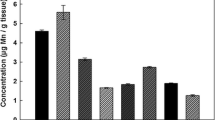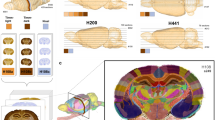Summary
From rats intravitally treated with dithizone (diphenyl-thiocarbazone) brains and spinal cords were removed and freeze-dried. The dithizonates present in the CNS tissue were extracted with carbon tetrachloride and subjected to a multielement analysis (proton activation, PIXE). It was found that the extract contained two metals. Most of the metal was zinc, but small traces of copper were also dectected. Because prior treatment with the chelating agent, dithizone, can block both the Timm and the selenium metal staining methods, it is suggested that the three techniques label predominantly zine in the neuropil (DTS-zine).
Similar content being viewed by others
References
Aigner A, Hornykiewicz O, Lisch H-J, Springer A (1967) Beeinflussung der Gehirn-Katecholamine, der Spontanaktivität und der l-DOPA Hyperaktivität durch Diäthyldithiocarbamat. Med Pharmacol Exp 17:576–585
Crawford IL, Doller HJ, Connor JD (1973) Diphenylthiocarbazone effects on evoked waves and zinc in the rat hippocampus. Pharmacologist 15:197
Danscher G (1976) Heavy metals in the hippocampal region. Some aspects of localization, function and content with special emphasis on the effect of chelating agents. Thesis, University of Aarhus, Denmark
Danscher G (1982) Exogenous selenium in the brain. A histochemical technique for light and electron microscopical localization of catalytic selenium bonds. Histochemistry 76:281–293
Danscher G (1984a) Similarities and differences in the localization of metals in rat brains after treatment with sodium sulphide and sodium selenide. In: Frederickson CJ, Howell GA, Kasarskis E (eds) Neurobiology of zinc, Part A. Alan R Liss, New York, pp 229–242
Danscher G (1984b) Do the Timm sulphide silver method and the selenium method demonstrate zinc in the brain? In: Frederickson CJ, Howell GA, Kasarskis E (eds) Neurobiology of zinc, Part A. Alan R Liss, New York, pp 273–287
Danscher G (1984c) Dynamic changes in the stainability of rat hippocampal mossy fiber boutons after local injection of sodium sulphide, sodium selenite, and sodium diethyldithiocarbamate. In: Frederickson CJ, Howell GA, Kasarskis E (eds) Neurobiology of zinc, Part B. Alan R Liss, New York, pp 177–191
Danscher G, Fredens K (1972) The effect of oxine and alloxan on the sulfide silver stainability of the rat brain. Histochemie 30:307–314
Danscher G, Haug F-MS, Fredens K (1973) Effect of diethyldithiocarbamate (DEDTC) on sulphide silver stained boutons. Reversible blocking of Timm's sulphide silver stain for “heavy” metals in DEDTC treated rats (light microscopy). Exp Brain Res 16:521–532
Danscher G, Shipley MT, Andersen P (1975) Persistent function of mossy fibre synapses after metal chelation with DEDTC (Antabuse). Brain Res 85:522–526
Euler C von (1962) On the significance of the high zinc content in the hippocampal formation. In: Passouant P (ed) Physiologie de l'hippocampe. Centre National de la Recherche Scientifique, Paris, pp 135–145
Fleischhauer K, Ohnesorge FK (1958) Zur Pharmakologie des Dithizon. Naunyn-Schmiedeberg's Arch Exp Pathol Pharmakol 235:63–77
Frederickson CJ, Howell GA (1984) Merits and demerits of zinc dithizonate histochemistry. In: Fredericksen CJ, Howell GA, Kasarskis E (eds) Neurobiology of zinc, Part A. Alan R Liss, New York, pp 289–303
Frederickson CJ, Howell GA, Frederickson MH (1981) Zinc dithizonate staining in the cat hippocampus: Relationship to the mossy-fiber neuropil and postnatal development. Exp Neurol 73:812–823
Friedman B, Price JL (1984) Fiber systems in the olfactory bulb and cortex: a study in adult and developing rats, using the Timm method with the light and clectron microscope. J Comp Neurol 223:88–109
Haug F-MS (1967) Electron microscopical localization of the zinc in hippocampal mossy fibre synapses by a modified sulphide silver procedure. Histochemie 8:355–368
Haug F-MS, Danscher G (1971) Effect of intravital dithizone treatment on the Timm sulfide silver pattern of rat brain. Histochemie 27:290–299
Hesse GW (1978) Chronic zinc deficiency alters neuronal function of hippocampal mossy fibers. Science 205:1005–1007
Howell GA, Welch MG, Frederickson CJ (1984) Stimulation-induced uptake and relcase of zinc in hippocampal slices. Nature 308:736–738
Howell GA, Pérez-Clausell J, Kemp K, Danscher G (1985) Chelatable zinc in the rat CNS. In preparation
Ibata Y, Otsuka N (1969) Electron microscopic demonstration of zinc in the hippocampal formation using Timm's sulphide silver technique. J Histochem Cytochem 17:171–175
Johansson SAE, Johansson TB (1976) Analytical application of particle induced X-ray emission. Nucl Instrum Methods 137:473–516
Kemp K, Danscher G (1979) Multi-element analysis of the rat hippocampus by proton-induced X-ray emission spectroscopy (phosphorus, sulphur, chlorine, potassium, calcium, iron, zinc, copper, lead, bromine, and rubidium). Histochemistry 59:167–176
Koenig W, Richter FW, Steiner U, Stock R, Thielman R, Wätjen U (1977) Trace element analysis by means of particle induced X-ray emission with triggered beam pulsing. Nucl Instrum Methods 142:225–229
Lenglet WJM, Bos AJJ, Stap CCAH, Vis RD, Delhez H, Hamer CJA (1984) Discrepancies between histological and physical methods for trace element mapping in the rat brain. Histochemistry 81:305–309
López Garcia C, Molowny A, Pérez-Clausell J (1984) Volumetric and densitometric study in the cerebral cortex and septum of a lizard (Lacerta galloti) using the Timm method. Neurosci Lett 40:13–18
Maj J, Vetulani J (1970) Some pharmacological properties of N,N-disubstituted dithiocarbamates and their effect on the brain catecholamine levels. Eur J Pharmacol 9:183–189
Maske H (1955) Über den topochemischen Nachweis von Zink im Ammonshorn verschiedener Säugetiere. Naturwissenschaften 42:424
McLardy T (1960) Neurosyncytial aspects of the hippocampal mossy fibre system. Confin Neurol (Basel) 20:1–17
Moore KE (1969) Effects of disulfiram and diethyldithiocarbamate on spontaneous locomotor activity and brain catecholamine levels in mice. Biochem Pharmacol 18:1627–1634
Otsuka N, Ibata Y (1966) Über die quantiativen Veränderungen des Zinkgehaltes in der Hippocampusformation nach der Dithizon-Zufuhr. Arch Histol Jpn 27:419–424
Pérez-Clausell J, Danscher G (1985) Intravesicular localization of zinc in rat telencephalic boutons. A histochemical study. Brain Res 337:91–98
Schrøder HD, Fjcrdingstad E, Danscher G, Fjerdingstad EJ (1978) Heavy metals in the spinal cord of normal rats and of animals treated with chelating agents: a quantitative (zinc, copper, and lead) and histochemical study. Histochemistry 56:1–12
Stampfl VB (1959) Die intravitale histochemische Darstellung des Zinks durch Dithizon. Acta Hisotchem 8:406–447
Szerdahclyi P (1982) Lack of correlation between trace metal staining and trace metal content of the rat hippocampus following colchicine microinjection. Histochemistry 74:563
Szerdahelyi P, Kása P (1984) Histochemistry of zinc and copper. Int Rev Cytol 89:1–33
Timm F (1958) Zur Histochemie der Schwermetalle. Das Sulfid-Silber-Verfahren. Dtsch Z Gesamte Gerichtl Med 46:706–711
Timm F (1961) Der histochemische Nachweis des Kupfers im Gehirn. Histochemie 2:332–341
Walter RL, Willis RD, Gutknecht WF, Joyce JM (1974) Analysis of biological, clinical, and environmental samples using proton-induced X-ray emission. Anal Chem 46:843–855
Author information
Authors and Affiliations
Rights and permissions
About this article
Cite this article
Danscher, G., Howell, G., Pérez-Clausell, J. et al. The dithizone, Timm's sulphide silver and the selenium methods demonstrate a chelatable pool of zinc in CNS. Histochemistry 83, 419–422 (1985). https://doi.org/10.1007/BF00509203
Accepted:
Issue Date:
DOI: https://doi.org/10.1007/BF00509203




